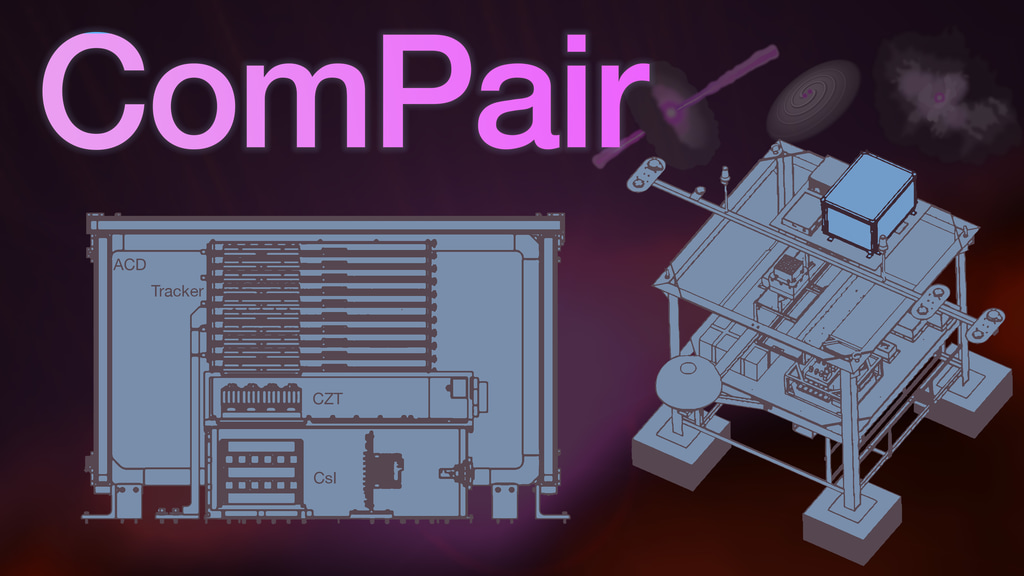ComPair Gamma-Ray Balloon Mission
Carolyn Kierans, principal investigator for the ComPair balloon mission at NASA’s Goddard Space Flight Center in Greenbelt, Maryland, works on the instrument in this video. First, she assembles a layer of the tracker, which is housed in an aluminum casing. Next, she shows one of the tracker’s silicon detectors. Then she takes the lid off the tracker.
Credit: NASA/Sophia Roberts
Engineers and scientists assembled and tested NASA’s ComPair (short for Compton Pair) balloon instrument in preparation for its scheduled flight in August 2023 as part of NASA’s fall balloon campaign from Fort Sumner, New Mexico. ComPair’s goal is to test new technologies for studying gamma rays, the highest-energy form of light. The imagery here was captured at different stages of the mission’s assembly and testing in 2022 and 2023.
ComPair is designed to detect gamma rays with energies between 200,000 and 20 million electron volts. (For comparison, the energy of visible light is 2 to 3 electron volts.) Supernovae and gamma-ray bursts, the most powerful explosions in the cosmos, glow brightest in this range, as do the most massive and distant active galaxies, which are powered by supermassive black holes.
ComPair gets its name from the two ways it detects and measures gamma rays: Compton scattering and pair production. Compton scattering occurs when light hits a particle, such an electron, and transfers some energy to it. Pair production happens when a gamma ray grazes the nucleus of an atom. The interaction converts the gamma ray into a pair of particles – an electron and its antimatter counterpart, a positron.
The ComPair instrument has four major components:
1. A tracker containing 10 layers of silicon detectors that determine the position of incoming gamma rays.
2. A high-resolution calorimeter that precisely measures the lower-energy Compton-scattered gamma rays.
3. Another calorimeter that measures the higher energies of electron-positron pairs.
4. An anticoincidence detector that detects the entry of high-energy charged particles called cosmic rays, allowing ComPair's other instruments to ignore them.
ComPair is a collaboration among Goddard, the Naval Research Laboratory in Washington, Brookhaven National Laboratory in Upton, New York, and Los Alamos National Laboratory in New Mexico.
This video shows engineers and scientists at Goddard testing ComPair’s high-resolution, low-energy calorimeter. The first shot shows a radioactive source used to determine if the calorimeter correctly detects gamma rays. The second shot pans down from the source to the 10-layer tracker on top of the calorimeter. The third, fourth, and fifth shots show data readouts from the calorimeter. The sixth shot shows a pan up from ComPair's multiple power sources to its instruments on the tabletop. Lucas Smith (University of Maryland, College Park) watches the data readouts from the calorimeter. The seventh shot shows some of the ComPair peripheral electronics, specifically the trigger module that aligns the data from each subsystem.
Credit: NASA/Sophia Roberts
Kierans prepares the instrument’s tracker for testing in a small thermal vacuum chamber at Goddard in this video. The first two shots show her opening the door to the chamber, which is used to test how the instrument works in temperatures from minus 76 degrees Fahrenheit (60 degrees below zero Celsius) to 86 F (30 C). The third shot shows Kierans and Sambid Wasti (Catholic University of America) moving the tracker into the chamber.
Credit: NASA/Sophia Roberts
Kierans checks on the instrument’s tracker after testing in a thermal vacuum chamber at Goddard in this video. In the first shot, she opens the chamber door and leans in with a light to look around the tracker. In the second shot, she examines the tracker more closely, moving aside coils of cables. The tracker uses five power supplies, all with different voltages. The result is a plethora of cables that require careful management.
Credit: NASA/Sophia Roberts

In this image, Smith holds up part of ComPair's high-resolution low-energy calorimeter, which uses a cadmium-zinc-telluride compound to detect the energy deposited in gamma-ray interactions.
Credit: NASA/Sophia Roberts
Credits
Please give credit for this item to:
NASA's Goddard Space Flight Center
-
Producer
- Sophia Roberts (Advocates in Manpower Management, Inc.)
-
Science writer
- Jeanette Kazmierczak (University of Maryland College Park)
-
Technical support
- Aaron E. Lepsch (ADNET Systems, Inc.)
Release date
This page was originally published on Thursday, May 25, 2023.
This page was last updated on Friday, May 19, 2023 at 9:04 AM EDT.


